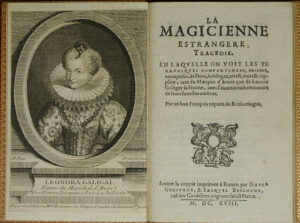I- Jouxte la coppie imprimee à Rouen par David Geoffroy, & Jacques Besongne, rue des Cordeliers joignant sainct Pierre, 1618.
II- A Paris, jouxte la copie imprimée à Rouen chez Thomas Mallart, s.d.
8vo [159 x 104 mm] of 32 pp. and 31 pp. Copper-engraved portrait of Odieuvre depicting Léonore Galigaï added at the beginning of the volume. Bound in light-brown full morocco from the 19th century, spine ribbed, red and green morocco lettering-pieces, inner gilt border, gilt edges. Binding signed Thibaron.
Rare reprint of the extremly rare first edition, of this anonymous tragedy composed in verses in the honour of the marchioness d’Ancre’s execution. On the original: Tchemerzine, IV, 647 ; Brunet, III, 1295 ; Barbier, 1869-1879, 107-108, Soleinne, Bibliothèque dramatique, 3730.
« Very rare. The author of this tragedy is Pierre Matthieu and not Pierre de Sainte-Marthe, like Leris says […]; the historiographer P. Matthieu , who had a strong vocation for the plays of that kind. We find in it simple, noble and touching verses; Galigay’s character is well painted, and the scene of the execution must have made a great effect on the audience, if it was performed. The characters are the great Pan françois (Louis XIII), Aymelis de L. (Luynes), Léontilde de V. (de Villeroy), Almidor de N. (de Nemours), Argente du M. (Maine), Lucidor de L. (de Longueville), the Solon françois (the president Deslandes), Galigay, etc. The author followed the spirit and the letter of the judgement that condemned the marshal’s wife as a witch and made her confess her evil spells […]. This tragedy, composed in honour of a legal assassination, is preceded by a sonnet in praise of the king. » (Soleinne, 3730)
« Eléonore Galigaï, daughter of a joiner, married the famous and unlucky Concini, ever since marshal d’Ancre. Galigaï came to France with Marie de’ Medici, of whom she was foster sister; she obtained for her husband with intrigue the most brilliant positions. The insolent abuse they made of their favours aroused all those in high places in the Court, and especially Louis XIII. Concini was killed and his wife taken to the Bastille. She was ascribed a thousand crimes, and especially the one of magic. This trial started on May 3rd 1617, says Anquetil; she was condemned, on July 8th, to be decapitated and to have her body burnt, she died without bravado nor fright […]. A tragedy was made about her death, entitled: ‘La Magicienne étrangère’, in 4 acts and in verses, Rouen, 1617, 8vo ». (Peignot, Dictionnaire biographique et bibliographique, 8).
« Rare piece » emphasizes Brunet.
« M. Paul Lacroix (Catal. Soleinne, n° 3730), points out in this tragedy simple, noble and touching verses. There are other editions of this tragedy that provoked a vivid feeling of curiosity; it perfectly met the passions of the day. » (Barbier, 107-108).
« A 32-page play, very scarce; it tackles the marshal d’Ancre’s wife, after her tragic ending, with cruel relentlessness. The character of the unfortunate Galinaï is well painted. » (Robert Naumann, Serapeum, 26)
This violent pamphlet published anonymously against the marhsal d’Ancre’s wife was such a success that it was reprinted several times between 1617 and 1626.
Bound with the present work is another play, also rare as well, that tells Concini’s murder, on April 24th 1617. It is the reprint of the first edition. (Brunet, V, 910; Soleinne, 3729)
« The “Paris, jouxte la copie imprimée à Rouen” edition has been copied, page for page and line for line from the first edition. » (Brunet)
« Very scarce piece that reproduces in the dramatic form the historical details of the marshal d’Ancre’s murder, on the Louvre’s drawbridge, by Charles d’Albert, duke of Luyne, Vitry and other king agents. The characters of this tragedy are Python M.D. (marquis d’Ancre), Phebus, R. de F. (king of France), Lydor de G. (de Guise), Alcé D.D., Antimars de V. (Vitry), Galligay, Ruburo Demon (Montalto, Venetian astrologer), Cleridam de L. (de Luynes), Theocrat de V. (de Villeroy), Arlin du M. (du Maine), Toleon de N. (de Nemours). […] It is possible that the author introduced himself under the poet named Alcé D.D. These two initials would represent then the name of Mr de Deimiers, author of the “Liberté royale de Marseille”, work published in Paris in 1615, with the same initials. » (Soleinne, 3729)
No copy of one or the other of these two texts has been recorded on the public market for more than thirty years.
A precious copy gathering two pamphlets of the highest historical interest.
Provenance: from E.M. Bancel’s collection with exlibris.

![La Magicienne estrangere, Tragedie. En laquelle on voit les tiranniques comportemens, origine, entreprises, desseins, sortileges, arrest, mort & supplice, tant du Marquis d’Ancre que de Leonor Galligay sa femme, avec l’avantureuse rencontre de leurs funestes ombres. Par un bon Français neveu de Rothomagus. [Suivi de] : -La Victoire du Phebus françois contre le python de ce temps. Tragedie. Où l’on voit les dessins, pratiques, Tyrannies, Meurtres, Larcins, Mort & Ignominie dudit Python.](https://www.camillesourget.com/wp-content/uploads/2023/03/mathieu_titre.jpg)
![La Magicienne estrangere, Tragedie. En laquelle on voit les tiranniques comportemens, origine, entreprises, desseins, sortileges, arrest, mort & supplice, tant du Marquis d’Ancre que de Leonor Galligay sa femme, avec l’avantureuse rencontre de leurs funestes ombres. Par un bon Français neveu de Rothomagus. [Suivi de] : -La Victoire du Phebus françois contre le python de ce temps. Tragedie. Où l’on voit les dessins, pratiques, Tyrannies, Meurtres, Larcins, Mort & Ignominie dudit Python. - Image 2](https://www.camillesourget.com/wp-content/uploads/2023/03/Matthieu-reliure.jpg)
